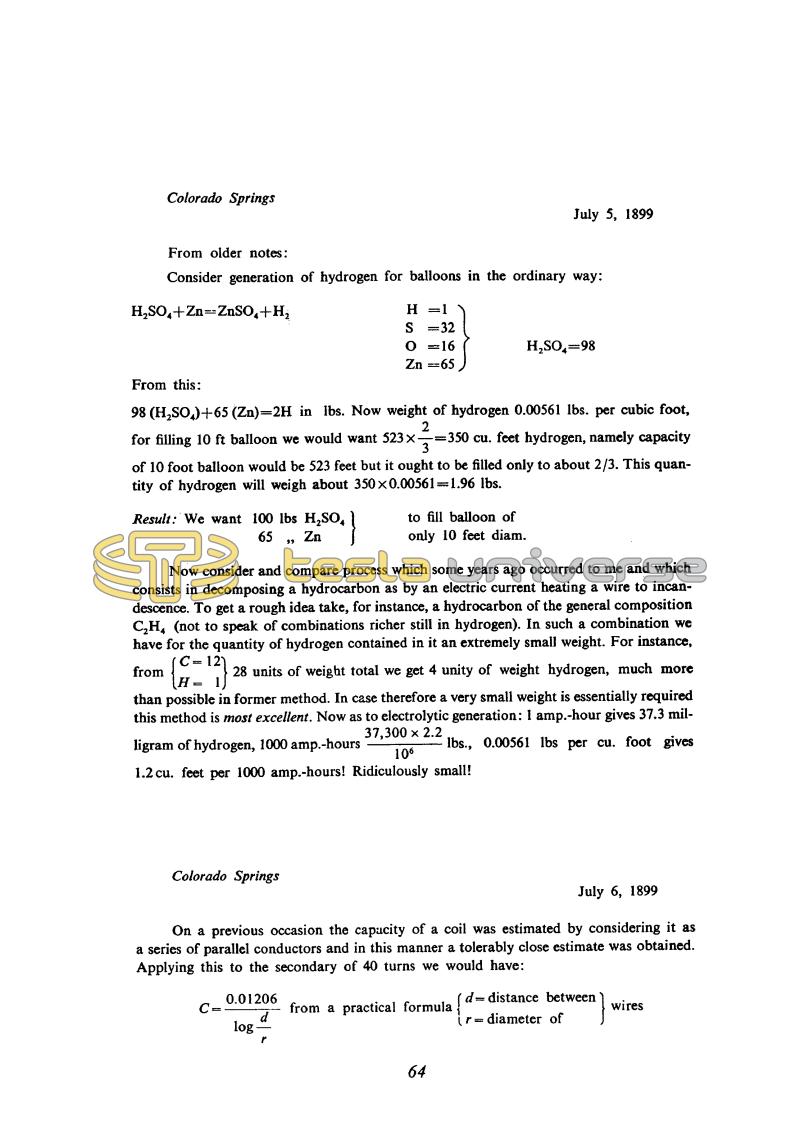
Nikola Tesla Books
Colorado Springs
July 5, 1899
From older notes:
Consider generation of hydrogen for balloons in the ordinary way:
| H2SO4 + Zn = ZnSO4 + H2 | H | = 1 | H2SO4 = 98 |
| S | = 32 | ||
| O | = 16 | ||
| Zn | = 65 |
From this:
98(H2SO4) + 65(Zn) = 2H in lbs. Now weight of hydrogen 0.00561 lbs. per cubic foot, for filling 10 ft balloon we would want 523 x !${2\over3}!$ = 350 cu. feet hydrogen, namely capacity of 10 foot balloon would be 523 feet but it ought to be filled only to about 2/3. This quantity of hydrogen will weigh about 350 x 0.00561 = 1.96 lbs.
| Result: We want | 100 lbs. H2SO4 | to fill balloon of only 10 feet diam. |
| 65 lbs Zn |
Now consider and compare process which some years ago occurred to me and which consists in decomposing a hydrocarbon as by an electric current heating a wire to incandescence. To get a rough idea take, for instance, a hydrocarbon of the general composition C2H4 (not to speak of combinations richer still in hydrogen). In such a combination we have for the quantity of hydrogen contained in it an extremely small weight. For instance, from ( C = 12 H = 1 ) 28 units of weight total we get 4 unity of weight hydrogen, much more than possible in former method. In case therefore a very small weight is essentially required this method is most excellent. Now as to electrolytic generation: 1 amp.-hour gives 37.3 milligram of hydrogen, 1000 amp.-hours 37,300 x 2.2 / 106 lbs., 0.00561 lbs per cu. foot gives 1.2 cu. feet per 1000 amp.-hours! Ridiculously small!
Colorado Springs
July 6, 1899
On a previous occasion the capacity of a coil was estimated by considering it as a series of parallel conductors and in this manner a tolerably close estimate was obtained. Applying this to the secondary of 40 turns we would have:
!$C = {0.01206 \over log {d \over r}}!$ from a practical formula ( d = distance betweenr = diameter of) wires
64
July 5
It is possible that Tesla was planning to construct a balloon to take an antenna to great height(13, 14), and was therefore interested in the generation of hydrogen. He does not give any indication, however, of whether he actually carried out any experiments in this direction, or of the grounds he had for expecting the desired decomposition to take place.
July 5
It is possible that Tesla planned the construction of a balloon which could serve the purpose of carrying high elevation antennas(13,14) and that is the reason why he considered the hydrogen production. He analyzed three variations and concluded that it is best to separate carbohydrogen C2H4 (non-saturated carbohydrogen-ethelene) by means of a red hot wire. However, he didn't give any data from which it could be seen that he experimented in that direction and on the basis of what he assumed that desired separation would be achieved.
July 6
Returning back to the problem of coil-form capacitance, he attempted to calculate by means of equation for the capacitance of two parallel symmetrical conductors, so that he takes half of the coil length as feeder length, and the distance between the conductors centers he takes it as equal to distance between centers of two adjacent coil turns. Calculated value for one coil convinced him that this method is not applicable because the difference between calculated and by indirect method determined distributed capacitance is too large.

